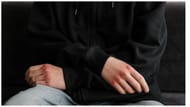Frostbite is brought on by exposure to extremely low temperatures, which causes skin and other tissues to freeze. Though it can also affect other exposed body parts, it typically affects the extremities, including the fingers, toes, nose, ears, cheeks, and chin. The freezing of the fluid inside cells results in this infection, which can cause tissue death and damage to cells.
A severe case of frostbite may require the affected body part to be amputated or surgically removed from your body, causing irreversible harm to your body.
What does a frostbite look like?
There could be color changes in your skin. It could appear white, gray-yellow, or paler than your typical skin tone, for example. Rewarming the region can cause painful and inflamed skin.
Common symptoms include:
Frostnip: The least severe kind results in tingling and numbness in the afflicted areas.
Superficial frostbite: At this stage, the skin may feel hard to the touch and seem pale or white. Along with discomfort and swelling as the affected area thaws, it could also be numb.
Deep frostbite: This is a more serious stage in which deeper tissues including muscles, tendons, and even bones are affected by the damage that goes beyond the surface. As the tissue degrades, the skin may become dark or even black.
Common causes

Your blood vessels constrict in response to low temperatures in your body. To allow your body to pump more blood and oxygen to your internal organs, this lowers blood flow to your extremities, which includes your hands, fingers, feet, and toes. Your extremities get colder and colder until ice crystals develop as blood flow and oxygen levels drop. Your cells and tissues could be seriously harmed by ice crystals.
Here are the common causes:
Cold temperature: Extended exposure to low temperatures, particularly in windy or damp circumstances, raises the possibility.
Inadequate clothes: Wearing wet clothing or not wearing enough layers to guard against the cold can lead to this infection.
Medical conditions: A number of illnesses, such as impaired nerve function or poor circulation, might make a person more vulnerable to this infection.
How to treat
The damaged area of frostbite must be gradually warmed up. The following are steps for treating:
Go to a warm environment: To stop additional heat loss, get as quickly as you can to a warm location.
Take off wet clothes: Wet clothes can make the cold feel worse. Take off any damp clothes and put on warm, dry layers in their place.
Warm the affected area: Gradually warm the affected area with warm, not hot, water. Since numb skin is more prone to burn, stay away from direct heat sources such as heaters and hot water bottles.
Prevent refreezing: After the damaged region has thawed, keep it covered and don't expose it to the cold again.
Pain management: Pain and inflammation can be controlled with over-the-counter painkillers. Serious situations might call for immediate medical attention, possibly even hospitalization.
Keeping dry, wearing suitable clothing for the weather, and limiting extended exposure to extremely cold temperatures are all important in preventing frostbite. It's critical to recognize the symptoms of frostbite and to respond quickly if you think someone may be impacted. Seek medical assistance right once if there are indications or if the infection is severe.
